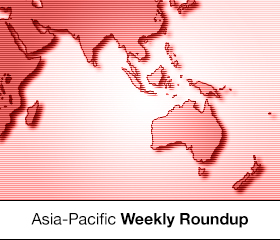APAC Marketers Drowning in Data Whirlpool; BuzzFeed Inks Joint Venture With Yahoo Japan


In this weekly segment, ExchangeWire sums up key industry updates on ad tech from around the Asia-Pacific region – and in this edition: Marketers drowning in whirlpool of data; BuzzFeed inks joint venture with Yahoo Japan; APAC mobile users most active on Wednesdays; and Dentsu Aegis releases whitepaper on Asia user engagement.
Marketers drowning in whirlpool of data
Marketers across the Asia-Pacific region have access to ample data, but are struggling to extract useful information that can help them make better decisions.
According to TNS Marketing Monitor, the immense volume and variety of data was making it difficult to gain valuable insights to gain a competitive advantage. The study polled 2,716 marketing professionals in the region, where 34% were managing real-time data in their role.
Although Asia-Pacific organisations were investing more in data-driven digital platforms and tracking systems to better understand the online environment, 70% of marketers found it challenging to integrate data from different sources. Many were struggling to consolidate traditional and digital measurements, despite recognising they should have more than enough data to make decisions in real-time, noted TNS, which is part of Kantar.
Unable to cope, marketers were choosing to go back to traditional metrics, with sales uplift measurements still the leading method used to evaluate the success of campaigns, the study found. These metrics, though, would not enable businesses to track ongoing impact of their campaigns, TNS cautioned, adding that they would then not be able to react to live issues and tweak their marketing efforts to produce more positive results.
In fact, 67% were frustrated over the lack of predictive insights generated by traditional market research.
In addition, 68% of marketers said analysis were "not actionable enough", while 66% said it was "too slow" to be of any use.

TNS' Asia-Pacific managing director of brand and communications, Nitin Nishandar, said: "The difficulties in extracting valuable insights from data means marketers have a rear-view mirror approach, only understanding their performance and brand equity weeks, or even months, afterwards. Real-time data needs to deliver real-time value, otherwise, it's just distracting noise.
"Instead of being daunted by the challenge, marketers should see this as a golden opportunity to leverage the data to build a fast-paced, real-time marketing function," Nishandar noted.
According to the TNS study, some markets were ahead of others in integrating data insights. Singapore, for instance, led the way with 55% of respondents monitoring social media to support their marketing decisions, followed by Malaysia at 50%. In comparison, 42% and 30% of their counterparts in India and China, respectively, were doing likewise.
BuzzFeed inks joint venture with Yahoo Japan
The viral social and news site has announced plans to launch a Japanese-language version through a joint venture with Yahoo Japan, making its first move away from having whole ownership of its global operations.

BuzzFeed President Greg Coleman
BuzzFeed President Greg Coleman said: "We've been really successful with the wholly owned and operated, organic-growth model we've used for launches in other countries, but in Japan we want to open with a partner who can help accelerate our growth. This is why a joint venture makes the most sense."
Noting that Yahoo has significant presence in the Japanese market, Coleman said the new partner had local cultural knowledge, established clientele, and strong revenue.
He did not provide financial details involved in the joint venture, but did say BuzzFeed Japan would have majority share and "editorial and creative independence". It would, however, tap Yahoo's expertise in localising content for the Japanese audience.
According to reports, Buzzfeed would own a 51% stake, while the remaining 49% would go to Yahoo.
Coleman said: "We'll provide the joint venture with BuzzFeed’s brand, proprietary technology platform, and philosophy and process for developing editorial content and native advertising. Yahoo will advise the joint venture on cultural matters, drive traffic to BuzzFeed Japan, and own the sales channel to bring BuzzFeed Japan to market."
With a monthly global audience of more than 200 million, BuzzFeed runs local sites in the UK, Brazil, France, Australia, India, Germany, Mexico, and Canada, and gets 45% of traffic from outside the US.
The partnership would offer BuzzFeed access to Yahoo's sizeable Japanese audience--88% of the local online community--and ties to local advertisers, reported Financial Times. Quoting Coleman, the report noted: "[Japan is in] very early stages of native advertising. In many ways, we'll be the first to market. That's terrific, but it also means you have to break the ice with a lot of marketers."
APAC mobile users most active on Wednesdays
The highest usage across mobile devices and highest number of reachable unique devices among consumers in Asia appears to be Wednesdays, according to Taiwan-based ad tech startup, Appier.
The cross-screen marketing technology provider was citing findings from its Asia Cross-Screen User Behaviour Research Report, which was based on data from campaigns it ran in the first half of 2015 across 10 Asian markets including Singapore, Australia, India, Indonesia, Japan, and Vietnam.
Appier also noted that, in terms of their effectiveness and user reception, different ad formats catered to different needs across multiple screen sizes. User preference for banners and interstitial ads depended on the size of the device screen as well as type of device used. "In most Asian markets, high conversion rates for online ads occurred on devices with high CTRs," it added.
The report revealed a growing trend for multi-device ownership, with almost 40% of such users in most Asian markets operating more than three devices. At 21.2%, Singapore boasted the highest percentage of users with three mobile devices, followed by Australia and the Philippines, at 20.8% each. Markets with the highest share of multi-device users with more than four devices were Japan and Taiwan at 32.7% and 25.7%, respectively.
In Singapore, smartphone usage was the highest on Wednesdays, while PC usage peaked on Tuesdays, and tablets on Saturdays. Mobile users in the city-state preferred small phones and large tablets when interacting with games banners, but preferred small tablets when interacting with interstitial games ads. Large phones and tablets saw greater interaction with retail banner ads and interstitial ads, respectively.
Appier CEO and Co-Founder Yu Chih-Han said: "We are fully aware that the vast majority of marketers are no longer approaching cross-screen and cross-platform advertising as an option, but rather as a top priority."
Dentsu Aegis releases whitepaper on Asia user engagement
The media network has commissioned a whitepaper detailing how new technologies are driving consumer engagement and transforming the marketing industry.
Produced by The Economist, the report looks at how mobile, social media, and e-commerce are converging to provide new platforms for engaging consumers in Asia, according to Dentsu Aegis Network.
Dentsu's Asia-Pacific chief innovation officer Arvind Sethumadhavan said: "Asian markets are leading the adoption of mobile internet platforms and consequently we are witnessing a mobile-first approach in people's behaviour and the solutions being developed. The acceleration of this convergent world in Asia creates great potential for businesses to seamlessly drive customers from the point of engagement to the point of transaction for sales.
"Companies need to view Asia as pilot markets to future-proof their business models and a hotbed for innovation prototyping," Sethumadhavan added.
Asia accounts for 57% of the world's population, 58% of mobile subscriptions, and 53% of online users, noted Justin Wood, chief economist at the Economist Corporate Network. Retail sales in Asia also were forecast to grow by 4.5% a year over the next five years, compared to a global average of 3%.
AdvertiserAgencyAnalyticsAPACBrandingCross-ChannelDataLocationMeasurementMobileNativePublisherSocial MediaTargeting








Follow ExchangeWire